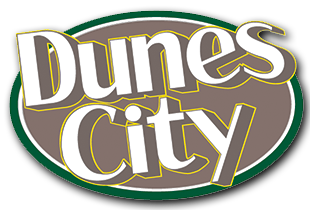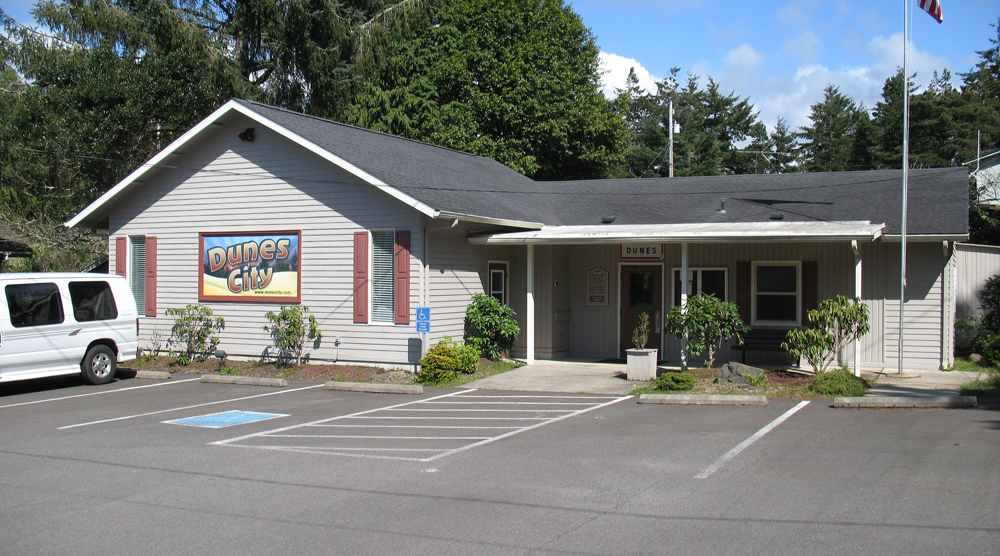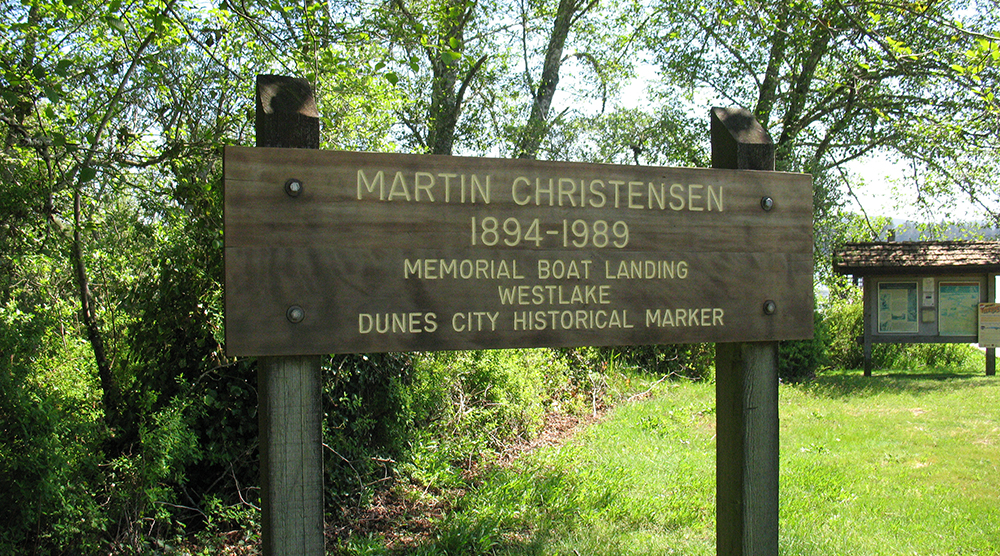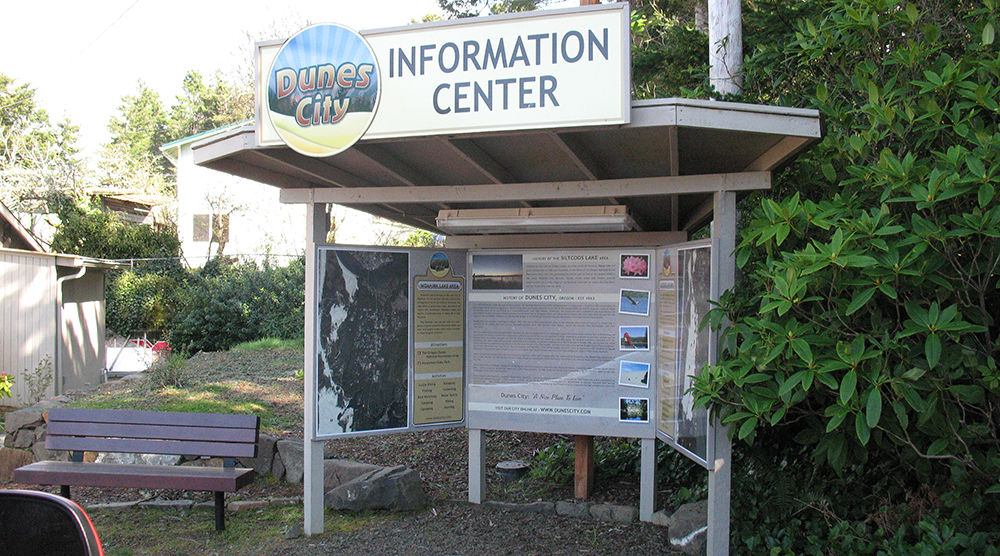History of Dunes City
In a 1957-58 Pacific Coast Recreation Area Survey, the National Park Service (NPS) initiated plans to incorporate a large area for preservation as the Oregon Dunes National Seashore. Various lands were previously acquired by the NPS in the United States for similar purposes. Some of these properties could not be purchased at a “reasonable price” from their owners. Therefore, the properties were condemned and acquired by the government anyway through eminent domain laws at prices set by the government and the property owners lost what they believed was the real value of their property. Residents of Dunes City sought to avoid this by incorporating and becoming a fully functioning municipality.
Dunes City was formally organized in August 1963. The town’s first meeting took place in the Woahink Lake home of Doctor E.S. Stong and in addition to Dr. Stong, the first Council members present were Phil Himmel (first Mayor), Martin Christensen, Ray Riesenhuber and Clair Hammond.
The first order of business brought before the new city was the appointment of a municipal judge, Bill Grenbremer, and the first ordinance passed concerned the construction of new houses and subdivisions within the city boundaries. A rather challenging problem for this new council was the Oregon state law which required all cities to adopt a budget before any spending could take place. No revenues could be collected until the following July when liquor and gas taxes would become available, so residents dedicated to the formation of Dunes City contributed the initial funds required for operations and this formed the basis for the City’s first budget. Initially there was a five person Budget Committee comprised. David Dier, Bernie LaForge, Ray Smith, Ted Simmoneau, and Bob Merz. Their initial budget required a vote of approval by the residents of Dunes City before any money could be spent so it is no surprise that Mayor Himmel was busy soliciting pledges of support from local residents.
Martin Christensen headed the Council’s Census Committee, which was charged with the responsibility of counting the Dunes City population. A census was required for the calculation and receipt of gas tax and liquor license revenues. This effort was vital to future Dunes City budgets and funding.
There were many challenges facing this fledgling city. Decisions would be required regarding sanitation and building codes, completion of census data, zoning, lawsuits, personnel, roads and police requirements. To help guide the Dunes City Council through it’s infancy, John Luvaas was employed as the first City Attorney.
More detailed information is available about these issues in a special scrapbook, which was assembled by local historians and is maintained at the Siuslaw Pioneer Museum in their library archives. Of special interest is a copy of the U.S. Department of Interior, National Park Service Question and Answer survey, which was created to answer questions regarding the government’s future proposed use and preservation plans for the Dunes Seashore Area.
The historical review of how this struggle continued will be covered in future editions of Dunes City Formation History.
Dunes City Personal Histories
Did you know. . . . on July 25, 1958 Boris Karloff’s vacation home on Siltcoos Lake located on Miller’s Arm burned. Electrical wiring was suspected as the cause of the fire. Bill Singer purchased the property and eventually sold it to Herb Robbins of Eugene. (Source, Siuslaw Oar)
Martin Christensen was one of Dunes City’s first council members and he recalled his early days on Siltcoos Lake in an article taken from an interview conducted by Kim Stafford for the Siltcoos Pioneer Museum on February 18, 1976.
Christensen was born on his parent’s homestead at Siltcoos Lake in June 1893. Both parents were from Denmark and his father started his life of adventure as a sailor when he ran away from home at the age of 14. He was an unusual runaway because he continued to return to his parent’s home at various intervals and since there were no objections raised to his escapades, he continued to leave and return until he was 22 years old when he finally left for America.
Christensen recalls logging their land with an ox team and afterwards they burned the logged out land so they could plow it. All the timber was virgin wood as the old growth forest was destroyed in a fire that swept through the area approximately 150 years earlier. He also remembered milking cows when he was as young as 7 years and his parents raised goats and sheep. It was hard to make money even though there was a mill at Cushman by 1898. The labor was hard and one earned $1 for a 10-12 hour day. It was necessary to stay in Cushman to work and in the fall workers would switch to commercial fishing.
The season opened about the first of August and ran until November. There were lots of fish then and a 25-pound Chinook salmon was typical. One earned two bits a piece for a 25 lb. Chinook and two bits for two fish less than 25 lbs. Christensen recalls that his father built the building at the Cushman Marina. Fishing was very important to the working families in the area and nets were used to catch the fish. According to Christensen there were as many as forty nets stretched at different levels across the river but there were so many fish, the net fishing techniques never seemed to diminish the quantity of fish moving upstream. The fish were sold to the canneries where the Chinese would can them for resale. Christensen could recall two canneries at the Cushman site, the Rosehill Cannery in Glenada and another cannery on the Florence side of the mill.
There were creameries and sawmills too. Besides the Cushman mill, the Saubert family also owned a mill, a store and a schooner. There were lots of schooners running the river then to move out lumber.
On their Siltcoos ranch, Christensen remembers they had more ranch land than most of the people around. They had two big barns and raised red clover but they had to wait their turn to use the only mowing machine in the area.
About 1914 the railroad started. During the period before the rail was built the Christensen’s made money running passengers across the lakes. There were five boys to run and manage six gas boats for passenger service, one on Woahink, one on Tahkenitch and four on Siltcoos Lake. The Porter brothers had a railroad contract to haul materials. They had a narrow gauge railroad, only about 2 feet wide, at Honeyman Park. All the pilings, railroad timbers and supplies would arrive and be towed by the Christensen’s across the lake. The family also had a stage line for about a year and a half until all the railroad work was completed.
In the winter, work was different. The Christensen family would quit whatever they were doing and trap beaver until the price dropped, and then it was back to the prior work routine.
Our next personality profile from the past will feature Muscrat Molly and Civet Cat Sue, two young wives who lived on the Siltcoos in 1942. Their real names are Neicy Prescott Steuvens and Rita Hansen and they were lady fur trappers. Watch the Dunes City web site for their unique story.





